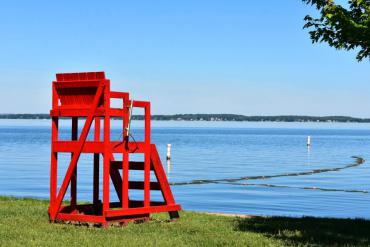Beach Water Quality Now Being Monitored for Summer
Monitoring Reduces Risk of Illness for People and Pets
Between Memorial Day and Labor Day, Public Health Madison & Dane County (PHMDC) Laboratory staff monitor conditions and test water at local beaches for bacteria and blue-green algae (cyanobacteria) to determine if they are safe for recreation and swimming, and to reduce the risk of illness.
Water is tested weekly at the beaches for the bacteria E. coli and blue-green algae. If a test shows concerning results, PHMDC will post signs at the beach and update the PHMDC beach website, indicating people should stay out of the water. Water quality is then checked each weekday until levels of bacteria and blue-green algae return to acceptable levels. Once levels are acceptable signs at the beach are removed and the beach website is updated.
There are numerous illnesses that can be transmitted via water. It is difficult to test waters for every possible type of illness-causing bacterium, so E. coli is used as an indicator organism. Their number indicate the likelihood of contracting an illness by recreating in or consuming water at a certain concentration of bacteria.
Blue-green algae, despite its name, is actually a group of bacteria known as cyanobacteria, which can produce toxins. Contact with these toxins can cause symptoms such as stomach upset, rashes, and respiratory irritation. Dogs that come into contact with harmful algal blooms can also get sick and sometimes die. Both people and pets should avoid being in water where harmful algal blooms are present.
Blue-green algal blooms vary in their appearance, looking like scum, foam, or a mat, and despite their name, can be different colors.
“We always check for blue-green algae blooms while visiting beaches for routine monitoring, but conditions can change quickly and algae may appear after our visit,” says Jennifer Lavender-Braun, PHMDC Microbiologist. “Once you get to the beach, always take a look at water conditions before getting into the water, especially after a heavy rainfall. That’s when stormwater runoff containing things like goose and pet waste can cause E. coli bacteria levels to be higher,” continues Lavender-Braun.
If you suspect there is a bloom at a beach, avoid the water and contact PHMDC at (608) 243-0357 so they can send someone out to check on the water quality conditions at that beach.
People can check to see if the water quality at a beach is acceptable for swimming and recreation before they go by checking the PHMDC website, checking the PHMDC Facebook and Twitter pages, or by signing up for beach water quality condition alerts. Even if one beach is closed for swimming, others may be open.
Contacts
- PHMDC Communications, (608) 243-0482, communications@publichealthmdc.com
